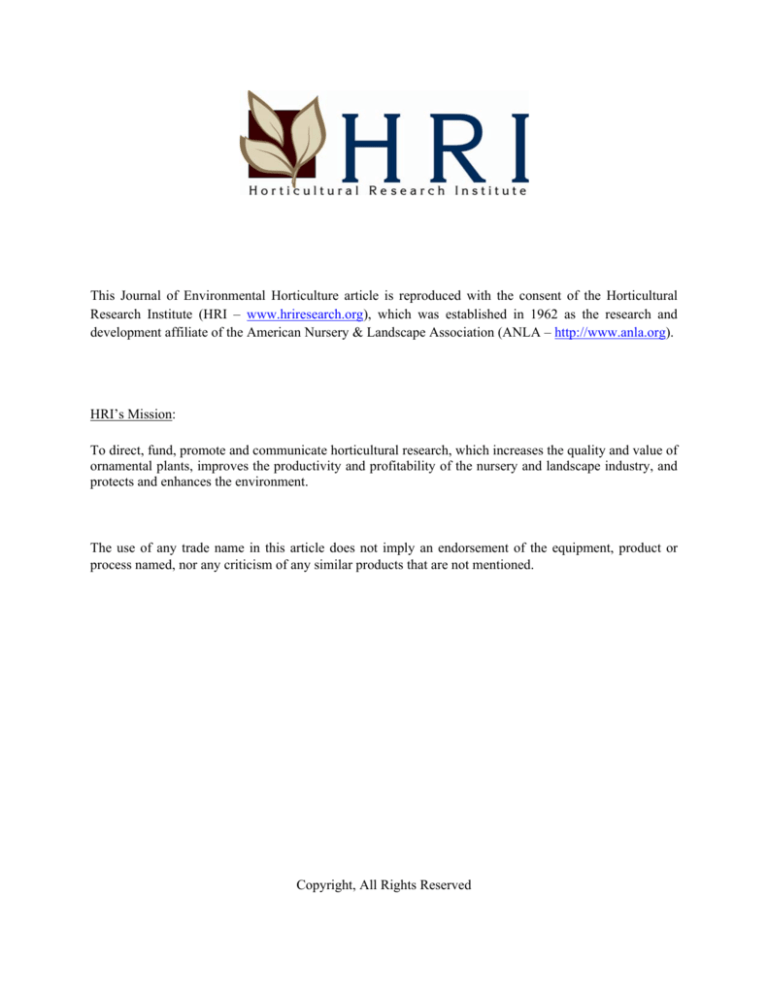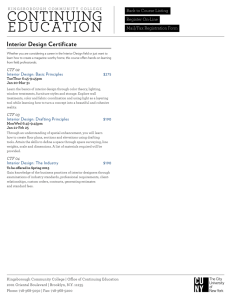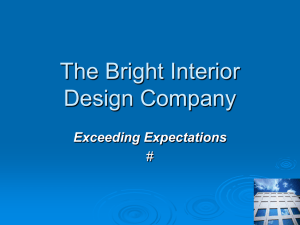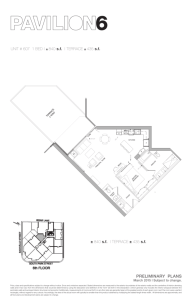
This Journal of Environmental Horticulture article is reproduced with the consent of the Horticultural
Research Institute (HRI – www.hriresearch.org), which was established in 1962 as the research and
development affiliate of the American Nursery & Landscape Association (ANLA – http://www.anla.org).
HRI’s Mission:
To direct, fund, promote and communicate horticultural research, which increases the quality and value of
ornamental plants, improves the productivity and profitability of the nursery and landscape industry, and
protects and enhances the environment.
The use of any trade name in this article does not imply an endorsement of the equipment, product or
process named, nor any criticism of any similar products that are not mentioned.
Copyright, All Rights Reserved
Interior Plants May Improve Worker Productivity and
Reduce Stress in a Windowless Environment1
Virginia I. Lohr, Caroline H. Pearson-Mims, and Georgia K. Goodwin 2
Department of Horticulture and Landscape Architecture
Washington State University, Pullman, WA 99164-6414
, - - - - - - - - - - - - - - - - - Abstract - - - - - - - - - - - - - - - - - - - ,
This study documents some of the benefits of adding plants to a windowless work place-a college computer lab. Participants' blood
pressure and emotions were monitored while completing a simple, timed computer task in the presence or absence of plants. When
plants were added to this interior space, the participants were more productive (12% quicker reaction time on the computer task) and
less stressed (systolic blood pressure readings lowered by one to four units). Immediately after completing the task, participants in the
room with plants present reported feeling more attentive (an increase of 0.5 on a self-reported scale from one to five) than people in
the room with no plants.
Index words: blood pressure, foliage plants, house plants, human issues in horticulture.
Significance to the Nursery Industry
Understanding the benefits of interior plants can help in­
terior plantscapers sell their services. This study provides
further justification for the use of interior plants in a variety
of indoor settings. Many people feel that adding plants to
interior spaces improves worker productivity and satisfac­
tion, yet there are lew, if any, concrete studies examining
these impacts. Studies showing an impact on blood pres­
sure, for example, have used videotapes of plants in natural
settings, not live containerized plants in interior settings.
This study, using common interior plants in a computer lab,
confirms that interior plants can contribute to reduced stress.
This study also documents that worker productivity on tasks
requiring concentration and quick reactions can improve
when plants are added to a work space.
Introduction
Interior plants are common in many homes, work places,
and commercial settings. Interiorscaping is widespread in
the hospitality industry, where its presence has been shown
to boost occupancy rates and generate profit (3). Intuitively,
people sense that contact with plants and nature is restor­
ative and calming to the human spirit. This widespread be­
lief is evidenced by the extensive landscaping in residential
communities, the use of plants in theme parks and other
segments of the tourist industry, the growth of urban and
community gardening, and interior plantscaping of office
and retail spaces (10, 13). In the 1960s, the open-plan 'of­
fice landscape,' characterized by the abundant use of large
potted plants to separate work spaces, was popular (14).
Although the office environment has changed over time,
interior plants continue to be used in work spaces. As jobs
become more technologically complex, the frequency of
stress-related disorders in work environments increases (2).
The need for a thorough understanding of the relationship
between plants and human well-being is increasingly im­
portant (10).
Interaction with plants, both passive and active, can
change human attitudes; behaviors, and physiological re­
sponses (0). The stress-reducing benefits of passively view­
ing plants in natural settings are well documented (5, 9, 15,
16); however, many workers labor in windowless office
spaces with few opportunities to view nature. Research in­
dicates that workers in such windowless environments have
lower job satisfaction and rate the physical conditions of
their work as less 'pleasant and stimulating' than people in
windowed settings (4). Plants are widely used to personal­
ize and decorate offices, and they are important in improv­
ing satisfaction with indoor space (7, 13).
Accounts of studies conducted in Germany in the 1960s
assert that improved employee morale, decreased absentee­
ism, and increased worker efficiency result when plants are
added to office spaces compared to traditional, unplanted
offices 0, 2). In the 1980s, reviews of the merits of interior
landscaping continued to suggest that plants boost employee
productivity, even by as much as 10% to 15%, when incor­
porated in offices and other work areas (8, 11). These re­
ports of increased worker productivity in interiorscaped of­
fices and work areas have been common; yet, we have been
unable to find any research studies to substantiate these
claims.
The goal of these experiments was to examine the im­
pacts of interior plants in a windowless working environ­
ment on human well-being and productivity. Responses of
subjects in the presence and absence of plants were com­
pared.
Materials and Methods
'Received for publication August 25, 1995; in revised form January 30, 1996.
The authors express appreciation for the assistance of Marvin Kleene (former
. coordinator of the computer lab) and Anthony Wright (Information Depart­
ment Computer Coordinator) and for the financial support of the American
Floral Endowment and The Horticultural Research Institute (Ernst
BietenhoWimperial Nurseries Grant>, 1250 I. Street, N.W., Suite 500,
Washington, DC 20005.
'Associate Professor, Research Technologist III, and Graduate Assistant, re­
spectively.
1. Environ. Hort. 14(2):97-100. June 1996
Experimental setting. Experiments were conducted in a
Washington State University instructional computer labora­
tory with 27 computer workstations. The room was 13.5 m
(44 ft) long, 7.3 m (24 ft) wide, and 2.6 m (8.5 ft) high. It
had no windows and was illuminated with overhead fluo­
rescent lights. The walls had no ornamentation and there
was a white markerboard across the front of the room. Most
of the interior of the room was off-white; the desk tops were
burnt orange. The conditions in the room averaged 27C
97
JI'"
(80F), 38% relative humidity, and 420 lux (38 fc) at the
work surface during both experimental treatments.
Subjects. A majority of the 96 participants were volun­
teers from an undergraduate agricultural economics class.
They ranged from 18 to 46 years old, and 78% were less
than 25 years old. Half of the subjects were male and half
were female. Eighty-four percent of the subjects were uni­
versity students; the remainder were university employees
or members of surrounding communities. All of the subjects
had used computers before, and most used computers at least
once a month. Half of the subjects reported their keyboard­
ing skills as average, while 20% felt that their skills were
slower than average and 30% felt that they were faster than
average. When asked if they liked plants, 81 % said 'yes'
and the remainder had either no opinion or said 'no.' Sixty­
six percent had plants at their homes or offices.
Correlations between responses to the demographic sur­
vey and treatment assignment were examined. There were
no significant correlations between any of the demographic
variables and treatment, except for that of having plants at
home or work. Approximately 75% of the subjects in the
treatment without plants had plants in their homes or work
areas, while only 58% of those assigned to the treatment
with plants had plants at home or work. Statistics examin­
ing the treatment by demographic response for this variable
and others that might have explained the results were also
examined, and no significant or meaningful relationships
were found. For example, people's levels of computer ex­
pertise did not influence how they responded to the treat­
ments. These analyses confirmed that there were no mean­
ingful differences between subjects in the treatment groups
and that the demographic variables were not useful in inter­
preting the results. For this reason, only the results for all
subjects within a treatment will be reported, and the statis­
tics for responses will not be categorized based on demo­
graphic responses.
A preliminary experiment, with slightly different proce­
dures, formed the basis for this experimental design. The
majority of the 160 subjects in the preliminary experiment
were volunteers from an upper level psychology class at
WSU, and their average age was 20.
Productivity. A computer program to test productivity and
induce stress was specifically designed for these experiments
Table 1.
Interior plants added to the computer lab during trials when
plants were present.
Species
Aglaonema sp.
Chamaedorea seifrizjj
Dracaena marginara
Dracaena deremensis 'Janel Craig'
Epipremnum aureum
Homalomena siesmeyeriana
Hoyasp.
Philodendron scandens
Sansevieria /rifascia/a
Scindapsus pic/us' Argyraeus'
Syngonium podophyllum
98
Quantity
Height or length
(em)
2
1
1
1
50
125
225
125
2
75
I
25
50
100
3
2
1
1
2
75
50
25
by the senior author and created by a computer specialist in
Information Systems at Washington State University. Tests
of reaction time are used to obtain an objective measure of
mental processing (\ 7). Our program randomly displayed
one of three shapes of different sizes, in various locations, at
random time intervals, on the computer screen. The vari­
ables that were incorporated into this program have been
associated with differences in reaction times (\ 7). Partici­
pants were asked to press a key that corresponded with the
shape on the screen as quickly as possible after they recog­
nized the shape. There was a specific key choice associated
with each shape; therefore, subjects had a choice of three
responses. Measures of reaction time where respondents have
more than one possible response are associated with com­
plex mental functioning and are considered appropriate in­
struments to measure performance under stressed or fatigued
conditions (17).
One hundred symbols were presented in the same ran­
domized sequence to each subject, thus keeping the com­
plexity of the task identical for all subjects. The time inter­
val after pressing the correct key, which cleared the screen,
until the next symbol appeared varied from zero to five sec­
onds. For each symbol presented, the number of wrong keys
pressed and the time delay before pressing the correct key
(reaction time) were automatically recorded in a computer
file. In the preliminary experiment, only 50 symbols were
presented, and the time delay between symbols ranged from
one to 15 seconds, making the task somewhat more boring
than the task used in the final experiment.
The computer program concept and content were reviewed
by a psychologist who considered it an appropriate instru­
ment to measure reaction time. The program was pretested
on various computers to ensure accurate recording of read­
ings. A group of computer users also pretested the program
to determine ease of usage. Blood pressure readings recorded
while using the program confirmed that the program was
effective in inducing stress.
Stress measures. Emotional states, blood pressure, and
pulse were measured for participants during the experiment.
The Zuckerman Inventory of Personal Reactions (ZIPER)
was used to monitor emotional states (18). Respondents in­
dicated, on a scale from one to five, the degree to which
each statement, such as 'I feel sad,' described the way they
felt at that moment. An Omron Model HEM-713C auto­
matic oscillometric digital blood pressure monitor (Omron
Healthcare, Inc., Vernon Hills, IL) was used to measure blood
pressure and pulse. Increases in blood pressure indicate in­
creases in stress (16). The cuff of the monitor was placed on
the subject's non-dominant arm, so that readings could be
taken while the subject was using the dominant hand for the
productivity task. Subjects were asked to place the cuffed
arm in a stationary and relaxed position during the mea­
surements.
Treatments and procedures. There were two treatments
in this experiment: plants present and plants absent. For the
treatment with plants present, common low-light tolerant
species of interior plants were added around the periphery
of the room (Table I). Floor plants, table plants, and hang­
ing plants were added, and they gave the appearance of a
well-designed, but not lush, interiorscape. Plants were posi­
tioned so that clusters would be present in the peripheral
J. Environ. Hort. 14(2):97-100. June 1996
L
view of each subject sitting at a computer terminal, but would
not interfere with the subject's activities.
Up to eight subjects were tested at one time. The subjects
entered the room and sat at designated terminals. Assistants
then led them through a series of tasks. Measures were taken
in the following order: pre-task ZIPER questionnaire, pre­
task blood pressure and pulse readings, computer produc­
tivity task with blood pressure and pulse measured approxi­
mately halfway through the task, post-task ZIPER question­
naire, post-task blood pressure and pulse readings, and the
demographic survey. Each subject was tested either in the
presence or the absence of plants, not under both conditions.
Statistical analyses. Data for subjects tested in the pres­
ence of plants were compared to that for subjects tested in
the absence of plants. A univariate analysis of variance was
performed on the productivity data, while a multivariate
analysis of variance was performed on changes in blood pres­
sure readings over time. Differences between treatments for
responses on the pre-task and post-task ZIPER questionnaires
were evaluated using the non-parametric Mann-Whitney 'U'
test in the NPARIWAY analysis in SAS (Cary, NC). For
ZIPER items with significant between treatment differences
and with pre-task to post-task score changes of more than
OJ units, the within treatment change was also evaluated
using a t-test. An alpha level of up to 10% was chosen for
this experiment for all parameters, to ensure that important
relationships would not be overlooked (6).
Results and Discussion
Stress measures. On the pre-task ZIPER survey, there were
no significant differences between people tested in the pres­
ence of plants compared to those tested in the absence of
plants. People generally reported moderate levels of posi­
tive emotions, such as feeling carefree or elated. They re­
ported low levels of negative emotions, including anger and
fear. After completing the productivity task, there were still
no differences on most items between those tested in the
presence of plants compared to those tested without plants.
There were differences on the item 'I feel attentive or con­
centrating' (Fig. 1). After completing the task, people in the
presence of plants reported feeling more attentive (an in­
crease of 0.5 units on a scale from one to five) than those in
the absence of plants. Comparisons within a treatment re­
vealed that subjects tested in the presence of plants showed
significant increases in their post-task attentiveness scores
over their pre-task scores (also an increase of 0.5 units, P <
0.01), while there were no changes in attentiveness for those
in the absence of plants. This is noteworthy, because atten­
tiveness is an important attribute for employees in most jobs.
There were no significant differences in pulse readings
(data not shown). Significant differences between treatments
were noted for systolic blood pressure (the upper number in
a typical blood pressure reading), based on the multivariate
analysis comparing changes among readings. People in both
treatments had similar systolic blood pressure readings be­
fore beginning the computer productivity task (Fig. 2). Sys­
tolic blood pressure rose for subjects in both treatments while
they were performing the productivity task. This suggested
that the task was inducing stress. The rise in blood pressure
was less for those subjects tested in the presence of plants
than for those tested without plants present (+ 1 and +4 units,
respectively). Subjects in both treatments experienced a drop
1. Environ. Hort. 14(2):97-100. June 1996
5
4.5
-
-
-
-_._-­
4
3.5
3
2.5
2
1.5
Pre-task
Fig. 1.
Post-task
Responses to statement 'I feel attentive or concentrating,' on a
scale from 1 (not at all) to 5 (very much), before and after com­
pleting a computer.based productivity task in the presence or
absence of plants (bars with different letters are different, P <
0.05).
in systolic blood pressure after completing the final set of
surveys, and the decrease was greater for those tested in the
presence of plants than for those tested without plants present
(-4 and -2 units, respectively). In the preliminary study,
blood pressure was measured only before and after the task,
not during the task. Similar trends in systolic blood pres­
sure were noted, but the changes were not significant. In
this study, as well as in the preliminary study, changes in
diastolic blood pressure were not significant, but the trends
were similar to those seen for systolic readings.
These results of a moderating influence of plants on blood
pressure are consistent with research conducted by others.
Ulrich and others (16) examined recovery rates in pre­
stressed subjects viewing videotapes of natural or urban set­
tings. He reported quicker and more complete recovery from
stress, using measures including pulse transit time, a corre­
late of systolic blood pressure, in subjects who viewed na­
ture scenes compared to those who viewed urban scenes.
This study confirms that live interior plants in containers
can induce the same response as videotapes of natural set­
tings.
-125
l
E
.s
l!!
120
!!
:I
~
'tl
~
115
£
~>­
l/l
110 + - - - - - - - - - . . . , - - - - - - - - - - - ,
Pre-task
Fig. 2.
During task
Post-task
Systolic blood pressure before, during, and after completing a
computer·based productivity task in the presence or absence
of plants (lines different, P = 0.076).
99
5
1.25
b
a
4
3
0.75
2
0.5
of productivity, but these results clearly demonstrate that
this area of research warrants more study.
Literature Cited
I. Conklin, E. 1974. Interior plantings bring nature indoors. Amer.
Nurseryman 139(2):12-13, 105-112.
2. Conklin, E. 1978. Interiorlandscaping. 1. Arboriculture 4: 73-79.
3. Evans. M.R. and H. Malone. 1992. People and plants: A case study in
the hotel industry. p. 220-222 In: D. Relf (Ed.). The Role of Horticulture in
Human Well-Being and Social Development: A National Symposium. Timber
Press, Portland. OR.
0.25
Plants
o .L--:':_
_
o
•
~ _
Errors
Reaction time
(wrong keys pressed)
(seconds per symbol)
Fig. 3.
Errors and reaction time on a computer-based productivity task
in the presence or absence of plants (bars with different letters
are different, P < 0.06).
Computer productivity test. The presence of plants had
no effect on the number of errors made on the productivity
test; subjects in both treatments made a similar number of
errors (Fig. 3). Reaction time in the presence of plants was
12% faster than in the absence of plants, indicating that
plants may have contributed to increased productivity (Fig.
3). In the preliminary study, using a version of the computer
productivity task presenting fewer symbols with longer de­
lays, reaction times in the presence and absence of plants
were not significantly different; however, the means were
consistent with the results of this study (6% faster with plants
than without plants).
These findings of quicker reaction times with plants
present than when absent on a task requiring some visual
concentration are consistent with claims of increased worker
productivity in the presence of plants (1, 2, 8, 11). We have
found no scientific studies documenting increased produc­
tivity in the presence of plants. The results of this study are
promising, indicating that there is truth in these claims. The
task used to measure productivity in this study involved vi­
sual concentration, mental processing, and manual dexter­
ity. The factors contributing to the productivity of actual
employees are complex and multifaceted. The full impact of
plants on worker productivity cannot be estimated from this
study, which examined only limited and short-term aspects
100
4. Finnegan, M.C. and L.Z. Solomon. 1981. Work attitudes in windowed
vs. windowless environments. J. Social Psychology 115:291-292.
5. Honeyman. M.K. 1992. Vegetation and stress: A comparison study of
varying amounts of vegetation in countryside and urban scenes. p. 143-145
In: D. Relf (Ed.). The Role of Horticulture in Human Well-Being and Social
Development: A National Symposium. Timber Press, Portland, OR.
6. Kirk. R.E. 1982. Experimental Design: Procedures for the Behavioral
Sciences. Brooks/Cole Publishing Company. Belmont. CA.
7. Laviana. 1.E., R.H. Manson, and EH. Rohles. 1983. Plants as enhancers
of the indoor environment. p. 738-741 In: A.T. Pope and L.D. Haugh (Eds.).
Proc. Human Factors Society 27th Ann. Mtg. Human Factors Society. Santa
Monica.CA.
8. Marchant, B. 1982. A look at the industry-dimensions and prospects.
Amer. Nurseryman 156(10): 30-49.
9. Moore. E.O. 1981-1982. A prison environment's effect on health care
service demands. J. Environ. Systems II: 17-34.
10. Relf. D. 1990. Psychological and sociological response to plants:
Implications for horticulture. HortScience 25: 11-13.
II. Scrivens. S. 1980. Interior Planting in Large Buildings. The
Architectural Press. London.
12. Sethi, A.S .• D.H.J. Caro. and R.S. Schuler. 1987. Conclusion: Towards
technological renaissance. p. 383-386In: Strategic managementofteehnostress
in an information society. C.J. Hogrefe. Inc., Lewiston, NY.
13. Shoemaker. C.A., K. Randall. P.D. Relf. and E.S. Geller. 1992.
Relationships between plants, behavior, and attitudes in an office environment.
HortTechnology 2:205-206.
14. Sundstrom, E. 1986. Work Places: The Psychology of the Physical
Environment in Offices and Factories. Cambridge University Press. New York.
NY.
15. Ulrich, R.S. 1984. View through a window may influence recovery
from surgery. Science 224:420-421.
16. Ulrich, R.S., R.E Simons, B.D. Losito, E. Fiorito. M.A. Miles, and M.
Zelson. 1991. Stress recovery during exposure to natural and urban
environments. 1. Environ. Psychology 11:201-230.
17. Welford, A.T. (Ed.). 1980. Reaction Times. Academic Press, London.
18. Zuckerman. M. 1977. Development of a situation-specific trait-state
test for the prediction and measurement of affective responses. J. Consulting
Clinical Psychology 45:513-523.
J. Environ. Hort. 14(2):97-100. June 1996








